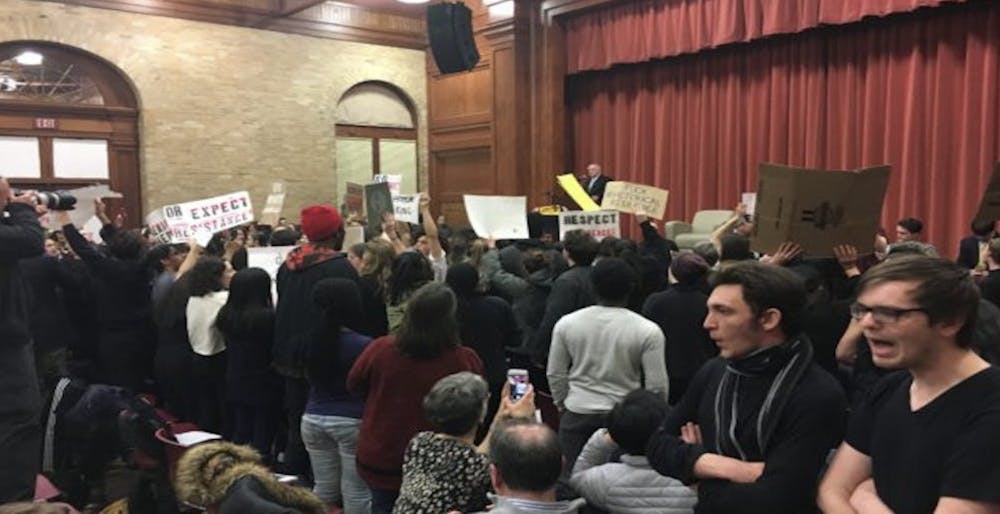In the spring of 2017, Charles Murray, a political scientist known for his controversial work “The Bell Curve” was invited by the American Enterprise Institute Club to speak at Middlebury College. His presence sparked student protests that not only disrupted his speech but also escalated to violence which left one faculty injured, drawing national media attention. In the aftermath, President Laurie Patton admitted that the college had not lived up to its foundational values and recognized the need to confront the "deep and troubling divisions" unveiled by the incident. Following these events, faculty issued a public statement, Free Inquiry on Campus, which emphasized the importance of “free, reasoned, and civil speech and discussion” as essential for authentic learning, labeling the prevention of speakers from speaking as a “coercive act.” Subsequently, Patton addressed the faculty in a commentary titled “Free Speech, Inclusivity, and the Public Sphere,” highlighting the critical situation facing Middlebury College as a leading institution committed to courageous engagement. In this address, she urged faculty members to inspire students to express themselves fearlessly and with conviction, emphasizing the dual role of education in introducing students to a range of ideas and preparing them to positively impact the world. Patton also pointed out the need to balance the challenge of a liberal education with acknowledgment of the hardships faced by students from marginalized communities. Shortly after, the college imposed disciplinary actions on 74 students, with consequences ranging from “probation to official college discipline.”
However, this was a missed opportunity to establish explicit standards for limits of academic freedom which has directly undermined our capacity for political discourse. In the absence of clear guidelines, students are left to independently draw the lines of acceptability. And because these vary drastically between individuals, it is common for the red line to become apparent only after a student perceives harm. The issue is further aggravated when our institutions regard this subjective perception as the limit of academic freedom. This situation leads to a cultural atmosphere of self-censorship and mistrust, where students are more focused on steering clear of any perceived harm. This is precisely what befell the Queer Studies House when a student reported discomfort with the acronym "FAGS!" on flyers for the House’s Friday Afternoon Group Sessions, a part of their social justice discussions. This report was escalated to the college’s Community Bias Response Team (CBRT). Despite the flyers' relevance to queer theory, they were taken down and faced criticism for including a potentially offensive slur. Arthur Martins ’23.5 reflected on the incident, stating, “What this instance highlights is the college trying to promote respectability or preserve the certain image, thereby preemptively censoring disruptive speech and thus creating a missed opportunity to engage with the discourse for academic growth.” Faculty, supporting the students, defended the flyers under academic freedom. Martins expressed concern that such incidents lead to “tangible anxiety” about making mistakes in speech, which inhibits open and confident participation in academic discussions.
While the college's reaction to the Murray incident might have been driven by intense scrutiny from national media and concerns about its reputation, in hindsight, I believe that the response proved inadequate and counterproductive. By framing the incident primarily as an affront to free speech, the college and the faculty failed to address the deeper questions at hand. In their rebuttal to the faculty statement, the student activists advocated for a "robust, nuanced, and continuing civil debate" on the “unassailable” principle outlined in the faculty's statement. They were not against free speech per se; rather, I believe they raised other critical questions: To what extent does academic freedom extend? Is it appropriate, under the banner of academic freedom, to invite a speaker with “racist” views to campus? For an environment to be truly inclusive and tolerant, is there a need to be intolerant of certain ideologies, and by extension, those who propagate them? If such views are not actively challenged, does this inadvertently lend them legitimacy? And is there a justification for disruption if checks and balances fail and the institution gives legitimacy to someone who propagated intolerable ideas, and if not, why? These are, unfortunately, the crucial questions that our community sidestepped in the wake of the incident.
Furthermore, during the conflict transformation dinner discussing the Israel-Palestine conflict on October 30, my table concurred that Middlebury's environment seems too insecure for nuanced conversations on such complex issues. This perspective has also been echoed by numerous students. In October, Shane Silverman ’24.5 critiqued what he called the "illiberal academic culture" at the college in response to the Editorial Board's reflections on the "shortfalls of our intellectual culture.” Weeks later, Griffin Fill ’23.5 attributed this to the emergence of “outrage culture,” a concept he cited as being borrowed from “right-wing” discourse. While these commentators may have some valid points, I contend that progress is unattainable without fully addressing the fundamental structural factors hindering meaningful debate on campus.
With the sixth anniversary of the Murray incident approaching, it's high time to reassess Middlebury’s stance on academic freedom and its boundaries. The first step to accomplishing this is a thorough interrogation of how we got here. Middlebury’s post-Murray response has produced anything but an effective strategy. It has left students in the untenable position of having to define the limits of academic freedom for themselves. This freedom cannot remain a mutually subjective abstraction. If we are to make any progress on this front, what is needed is a common framework with which to confront it, define it and enforce it. As a community, we have a collective duty to foster a welcoming atmosphere, ensuring our college remains a safe space for engaging in thoughtful and nuanced discussions on challenging subjects.


